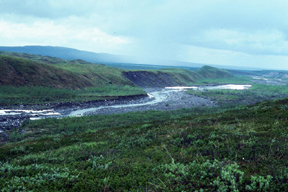 The more
than 150 countries participating in the Kyoto Protocol, the international treaty
to curb climate change through reduced greenhouse gas emissions, are having
a hard time staying on track to reach their 2012 emissions goals. As part of
the treaty, countries can buy and sell “credits” for carbon. Carbon
credit trading occurs in the United States on a voluntary basis, as the country
is not a party to the Kyoto Protocol. In such settings as the Chicago Climate
Exchange, major companies including International Paper and Ford Motor Company
sell and buy credits for activities that reduce their net greenhouse gas emissions,
including tree planting.
The more
than 150 countries participating in the Kyoto Protocol, the international treaty
to curb climate change through reduced greenhouse gas emissions, are having
a hard time staying on track to reach their 2012 emissions goals. As part of
the treaty, countries can buy and sell “credits” for carbon. Carbon
credit trading occurs in the United States on a voluntary basis, as the country
is not a party to the Kyoto Protocol. In such settings as the Chicago Climate
Exchange, major companies including International Paper and Ford Motor Company
sell and buy credits for activities that reduce their net greenhouse gas emissions,
including tree planting.The forest at the end of Denali Parkís Muldrow Glacier in Alaska is an example of taiga, a mix of dark-colored conifers that absorb the sunís radiative heat. That warming effect might cancel out efforts to cool the climate by storing carbon in trees planted in high and mid-latitudes. Image courtesy of Bruce Molnia, USGS.
Trees “sequester” carbon, by removing it from the atmosphere and storing it in their wood and in the soil. Australia, for example, which is also not a part of the Kyoto agreement, currently encourages farmers to rent their land to tree-planting organizations, in expectation that a ton of carbon sequestered could earn anywhere from $2 to $60. But to cool off in a warming climate, Australia may be better off planting trees in North America, according to new modeling results that have implications for carbon sequestration and other climate mitigation practices around the world.
The model’s challenge rests on two effects: Although trees pull carbon out of the atmosphere, causing cooling on a global scale, they also absorb radiated heat from the sun, as trees are dark and therefore have low reflectivity or “albedo.” Trees’ albedo could effectively cancel out successful carbon sequestration over a century, said Ken Caldeira of the Carnegie Institution’s Department of Global Ecology, in Stanford, Calif., in a presentation on Dec. 7 at the meeting of the American Geophysical Union (AGU) in San Francisco. That effect also makes tree planting more beneficial in some places than others.
In Caldeira’s team’s simulations, the results of which were also partially published in the Dec. 8 Geophysical Research Letters, planting trees in North America slightly warmed the continent locally because of albedo effects — but it cooled the planet elsewhere because of the removal of carbon dioxide from the atmosphere. However, trees in the tropics — the part of the planet that is seeing the fastest rates of deforestation — cooled the planet the most altogether.
Trees planted in boreal forests warmed the planet even more than mid-latitude trees, due to their changes to albedo: Earlier work has shown that trees in the Arctic tundra, for example, are helping to warm that region and melt snow cover there because they are so dark. The melting further reduces the region’s albedo by getting rid of snow’s reflecting white surface.
This “interesting study,” says Gordon Bonan of the National Center for Atmospheric Research, in Boulder, Colo., “seems to be pointing to results that are typical of these models and what other people are finding too,” with regard to changes in albedo and carbon storage, globally and locally. “Unfortunately, we’re having a hard time understanding what the net effect is.” Researchers are just starting to use models with connected ocean-atmosphere systems that include land cover and can address the consequences of changes in albedo versus carbon, says Gordon, who co-authored a similar study in the Dec. 8 Science.
The potential canceling-out effects of albedo for carbon sequestration raise questions as to whether tree planters should get carbon credits in North America, Caldeira says, particularly with the meeting of Kyoto Protocol participants under way in Montreal as he presented in San Francisco. His work also emphasizes the importance of tropical forests.
“From a climate mitigation point of view,” Caldeira said, “it depends on the characteristics of the forest.” Despite these local variations, however, Caldeira says that he strongly supports planting trees for ecosystems restoration anywhere, no matter what the impacts are on albedo. Planting trees to sequester carbon for credits in tropical countries may be a good solution, should these model results hold true, but other measures may be more effective in mid-latitude industrialized countries, from regulating public utilities to pumping industrial carbon dioxide emissions into the ground.
Making cuts in greenhouse gases immediately is the best solution and necessary, and even so, the climate will continue to warm, Jim Hansen, a climate researcher from NASA Goddard Institute for Space Studies in New York, told a standing-room-only audience at the December AGU meeting. The oceans have absorbed enough heat that it will take millennia for them to recover, leading to a “potential tipping point, not a runaway feedback,” he said, with the continued addition of greenhouse gases to the atmosphere.
The Kyoto Protocol ends in 2012, but the countries working under the agreement have yet to discuss what comes after, let alone whether they will be able to reach their self-imposed limits by then. They have many scientific, technological and political challenges to overcome, and pundits say that little progress was made at the Kyoto meeting in Montreal in December except for one point: The United States has reluctantly agreed to talk in the next round.

